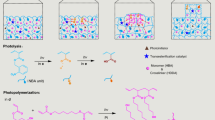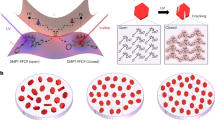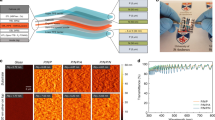Abstract
Some of the simplest light-harvesting systems in nature rely on the presence of surface structures to increase internal light scattering. We have extended this concept to increase the efficiencies of man-made solar energy harvesting systems. Specifically, we exploit the wrinkles and deep folds that form on polymer surfaces when subjected to mechanical stress to guide and retain light within the photo-active regions of photovoltaics. Devices constructed on such surfaces show substantial improvements in light harvesting efficiencies, particularly in the near-infrared region where light absorption is otherwise minimal. We report a vast increase in the external quantum efficiency of polymer photovoltaics by more than 600% in the near-infrared, where the useful range of solar energy conversion is extended by more than 200 nm. This method of exploiting elastic instabilities of thin, layered materials is straightforward and represents an economical route to patterning photonic structures over large areas to improve the performance of optoelectronics.
This is a preview of subscription content, access via your institution
Access options
Subscribe to this journal
Receive 12 print issues and online access
$209.00 per year
only $17.42 per issue
Buy this article
- Purchase on Springer Link
- Instant access to full article PDF
Prices may be subject to local taxes which are calculated during checkout




Similar content being viewed by others
References
Nalwa, K. S., Park, J.-M., Ho, K.-M. & Chaudhary, S. On realizing higher efficiency polymer solar cells using a textured substrate platform. Adv. Mater. 23, 112–116 (2011).
Garnett, E. & Yang, P. Light trapping in silicon nanowire solar cells. Nano Lett. 10, 1082–1087 (2010).
Battaglia, C. et al. Nanomoulding of transparent zinc oxide electrodes for efficient light trapping in solar cells. Nature Photon. 5, 535–538 (2011).
Tvingstedt, K., Zilio, S. D., Inganäs, O. & Tormen, M. Trapping light with micro lenses in thin film organic photovoltaic cells. Opt. Express 16, 21608–21615 (2008).
Sergeant, N. P. et al. Design of transparent anodes for resonant cavity enhanced light harvesting in organic solar cells. Adv. Mater. 24, 728–732 (2011).
Prodan, E., Radloff, C., Halas, N. J. & Nordlander, P. A hybridization model for the plasmon response of complex nanostructures. Science 302, 419–422 (2003).
Luther, J. M., Jain, P. K., Ewers, T. & Alivisatos, A. P. Localized surface plasmon resonances arising from free carriers in doped quantum dots. Nature Mater. 10, 361–366 (2011).
Henzie, J., Lee, M. H. & Odom, T. W. Multiscale patterning of plasmonic metamaterials. Nature Nanotech. 2, 549–554 (2007).
Gao, H. et al. Broadband plasmonic microlenses based on patches of nanoholes. Nano Lett. 10, 4111–4116 (2010).
Bowden, N. et al. Spontaneous formation of ordered structures in thin films of metals supported on an elastomeric polymer. Nature 393, 146–149 (1998).
Pocivavsek, L. et al. Stress and fold localization in thin elastic membranes. Science 320, 912–916 (2008).
Kim, P., Abkarian, M. & Stone, H. A. Hierarchical folding of elastic membranes under biaxial compressive stress. Nature Mater. 10, 952–957 (2011).
Sun, Y. et al. Controlled buckling of semiconductor nanoribbons for stretchable electronics. Nature Nanotech. 1, 201–207 (2006).
Khang, D.-Y., Jiang, H., Huang, Y. & Rogers, J. A. A stretchable form of single-crystal silicon for high-performance electronics on rubber substrates. Science 311, 208–212 (2006).
Yu, C. et al. Stretchable supercapacitors based on buckled single-walled carbon-nanotube macrofilms. Adv. Mater. 21, 4793–4797 (2009).
Qi, Y. et al. Piezoelectric ribbons printed onto rubber for flexible energy conversion. Nano Lett. 10, 524–528 (2010).
Lipomi, D. J., Tee, B. C. K., Vosgueritchian, M. & Bao, Z. Stretchable organic solar cells. Adv. Mater. 23, 1771–1775 (2011).
Koo, W. H. et al. Light extraction from organic light-emitting diodes enhanced by spontaneously formed buckles. Nature Photon. 4, 222–226 (2010).
Brau, F. et al. Multiple-length-scale elastic instability mimics parametric resonance of nonlinear oscillators. Nature Phys. 7, 56–60 (2011).
Schnell, M. et al. Nanofocusing of mid-infrared energy with tapered transmission lines. Nature Photon. 5, 283–287 (2011).
Verhagen, E., Spasenovicacute, M., Polman, A. & Kuipers, L. Nanowire plasmon excitation by adiabatic mode transformation. Phys. Rev. Lett. 102, 203904 (2009).
van Dillen, T., Polman, A., van Kats, C. M. & van Blaaderen, A. Ion beam-induced anisotropic plastic deformation at 300 keV. Appl. Phys. Lett. 83, 4315–4317 (2003).
Kim, J. B. et al. Small-molecule thiophene–C60 dyads as compatibilizers in inverted polymer solar cells. Chem. Mater. 22, 5762–5773 (2010).
Guan, Z.-L. et al. Direct determination of the electronic structure of the poly(3-hexylthiophene):phenyl-[6,6]-C61 butyric acid methyl ester blend. Org. Electron. 11, 1779–1785 (2010).
Wang, H. et al. Device characteristics of bulk-heterojunction polymer solar cells are independent of interfacial segregation of active layers. Chem. Mater. 23, 2020–2023 (2011).
Lee, J. K. et al. Efficacy of TiOx optical spacer in bulk-heterojunction solar cells processed with 1,8-octanedithiol. Appl. Phys. Lett. 92, 243308 (2008).
Blom, P. W. M., Mihailetchi, V. D., Koster, L. J. A. & Markov, D. E. Device physics of polymer:fullerene bulk heterojunction solar cells. Adv. Mater. 19, 1551–1566 (2007).
Vandewal, K. et al. The relation between open-circuit voltage and the onset of photocurrent generation by charge-transfer absorption in polymer:fullerene bulk heterojunction solar cells. Adv. Funct. Mater. 18, 2064–2070 (2008).
Street, R. A., Song, K. W., Northrup, J. E. & Cowan, S. Photoconductivity measurements of the electronic structure of organic solar cells. Phys. Rev. B 83, 165207 (2011).
Atwater, H. A. & Polman, A. Plasmonics for improved photovoltaic devices. Nature Mater. 9, 205–213 (2010).
Ferry, V. E., Sweatlock, L. A., Pacifici, D. & Atwater, H. A. Plasmonic nanostructure design for efficient light coupling into solar cells. Nano Lett. 8, 4391–4397 (2008).
Ferry, V. E. et al. Improved red-response in thin film a-Si:H solar cells with soft-imprinted plasmonic back reflectors. Appl. Phys. Lett. 95, 183503 (2009).
Baca, A. J. et al. Semiconductor wires and ribbons for high-performance flexible electronics. Angew. Chem. Int. Ed. 47, 5524–5542 (2008).
Acknowledgements
This work was supported by a grant from the Photovoltaics Program at ONR (N00014-11-10328) to J.B.K and Y.-L.L. J.B.K., Y.-L.L., P.K. and H.A.S. also acknowledge funding through the Princeton Center for Complex Materials, an NSF-sponsored MRSEC (DMR-0819860). N.C.P. and J.W.F. acknowledge the support of the Air Force Office of Scientific Research (US-AFOSR). S.J.O. and C.R.K. acknowledge the support of the NSF CBET programme (CBET-0854226). The authors would also like to thank B. Rand of IMEC for extensive discussions.
Author information
Authors and Affiliations
Contributions
J.B.K. fabricated and tested the polymer solar cells on rigid and flexible substrates. P.K. constructed the surfaces with wrinkles and folds. N.C.P. performed optical simulations and theory. J.B.K. and S.O. carried out local photocurrent mapping. All authors were involved in extensive discussions and data analyses. J.B.K. and Y.-L.L. wrote the manuscript with input from the other authors.
Corresponding author
Ethics declarations
Competing interests
The authors declare no competing financial interests.
Supplementary information
Supplementary information
Supplementary information (PDF 1519 kb)
Rights and permissions
About this article
Cite this article
Kim, J., Kim, P., Pégard, N. et al. Wrinkles and deep folds as photonic structures in photovoltaics. Nature Photon 6, 327–332 (2012). https://doi.org/10.1038/nphoton.2012.70
Received:
Accepted:
Published:
Issue Date:
DOI: https://doi.org/10.1038/nphoton.2012.70
This article is cited by
-
Measuring nanoparticles shape by structured illumination
Scientific Reports (2024)
-
Probing the effect of precursor concentration on the growth and properties of titanium dioxide nanocones for environment safe solar cells
Environmental Science and Pollution Research (2023)
-
Depressed carrier recombination for organic solar cells by doping IEICO-4F molecule
Journal of Materials Science: Materials in Electronics (2023)
-
Spontaneous Wrinkle Formation on Polydimethylsiloxane Using Plasma Immersion Ion Implantation: Influence of Ion Species and Pulse Frequency
Plasma Chemistry and Plasma Processing (2023)
-
Photo-induced stress relaxation in reconfigurable disulfide-crosslinked supramolecular films visualized by dynamic wrinkling
Nature Communications (2022)



